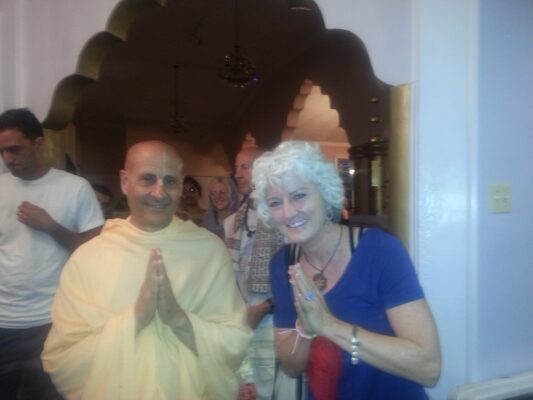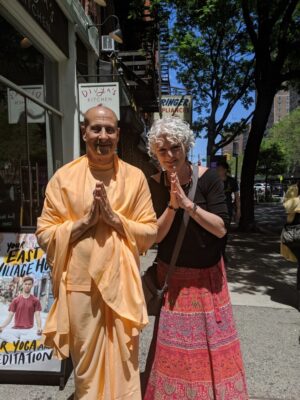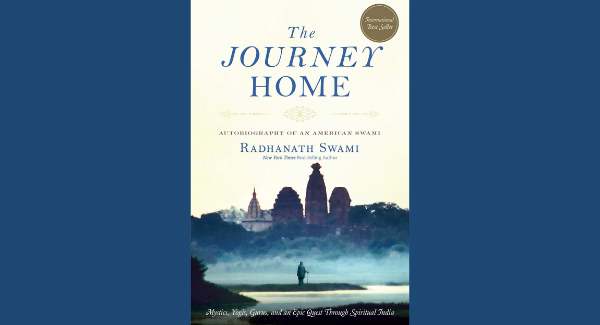While many may know her as a professor of English, Marguerite Regan, Ph.D., is also an observant storyteller and published author of the 2010 collaboratively composed novel, “The Journey Home: Autobiography of an American Swami.”
This journey she helped give voice to might as well be a modern epic, equipped with a call-to-action, inner searching and the triumphs and failures that accompany all of it.
The book explores the pilgrimage of a young Richard Slavin, who later becomes Radhanath Swami.
“The theme of Radhanath Swami’s work, and my own work with him, was one of saying yes to the adventure of life and to do things out of love. So I refer to this work I did with him as a ‘labor of love.’”
Paraphrasing certain parts of the novel, Regan provided some exposition and an overall outline of Swami’s quest.
“The year was 1969. Richard was a 19-year-old college student who yearned for a meaningful life and ideals to live by. He and his best friend, Gary, had been hitchhiking all over Europe for months. Now, on the steep and rocky coast of the Isle of Crete, they were living in a cave. Every morning before sunrise, Richard would climb a nearby mountain overlooking the sea to meditate and fast until sunset.”
Regan explained how Swami was inspired to take the next step in his spiritual journey in a truly divine call-to-action.
“One day as the sun was dropping into the mouth of the sea, he heard from his heart, a sweet but commanding voice. ‘Go to India,’ it said.”
This epic call-to-action would ultimately result in two journeys: the physical pilgrimage that Swami embarked on, and the narrative voyage that Regan would later illuminate.
Though some may consider this act of writing another person’s story “ghost-writing,” this term does not necessarily capture the collaborative elements of storytelling present in this piece.

Inside the book’s cover, Swami thanked Regan for her “invaluable contribution to the manuscript through research, writing and editing skills, love and humor, and for attempts to teach (him) to write.”
It was a partnered effort. With Swami’s captivating oral storytelling and Regan’s technical and narrative expertise, they breathed life into this incredibly human tale.
Of course, just as every physical pilgrimage has its obstacles, the act of retelling someone’s spiritual journey presented its own challenges.
Keeping track of one’s own writing and all the drafts that come with it is difficult enough, so understandably, working with two writers can cause a lot of “version confusion,” as Regan would explain. The greater challenge when it comes to memoirist or autobiographical writing, however, is balancing literal and emotional truth.
As they were working on a somewhat abstract scene where Swami was meditating with a friend, it became a lesson in dialogue, and painting a picture that tells the emotional truth for the sake of the readers.
Swami was telling Regan that he and a friend had returned to their cave one day and started exchanging their revelations. She believed the sentiment was vital to the story, but it was initially “off in the clouds, and needed to be grounded” in the form of a concrete narrative.
“We have to create more of a scene here,” she said to him. “What were you doing?”

“I don’t remember,” Swami responded.
“Well, for the sake of literary narration, memoirist writing deals with the literal truth versus the emotional truth, the essence of the truth. What’s really important here is the emotional truth, because of course, we don’t remember certain details, but for the sake of literary narrative and our readers, we need to include some of these details.”
According to Regan, the duty of the memoirist or the biographer, therefore, is not to create an exact replica of a person’s life, but to shed light on some emotional or intellectual truth within that person’s life. When this is done skillfully, it allows readers to gain wisdom from the triumphs and failures of others simply by reading and heeding their stories.
In the instance of “The Journey Home,” the advice readers are given is to “say yes to the adventure of being alive.”
To put it in other words, Regan shared a quote from one of her favorite passages from Thích Nhất Hạnh, a Vietnamese Thiền Buddhist monk, peace activist and poet.
“You are here for life, and if you are here for life, life will be here for you.”
If you are interested in reading more about the journey of Swami, you can purchase a copy of “The Journey Home” on Amazon.


